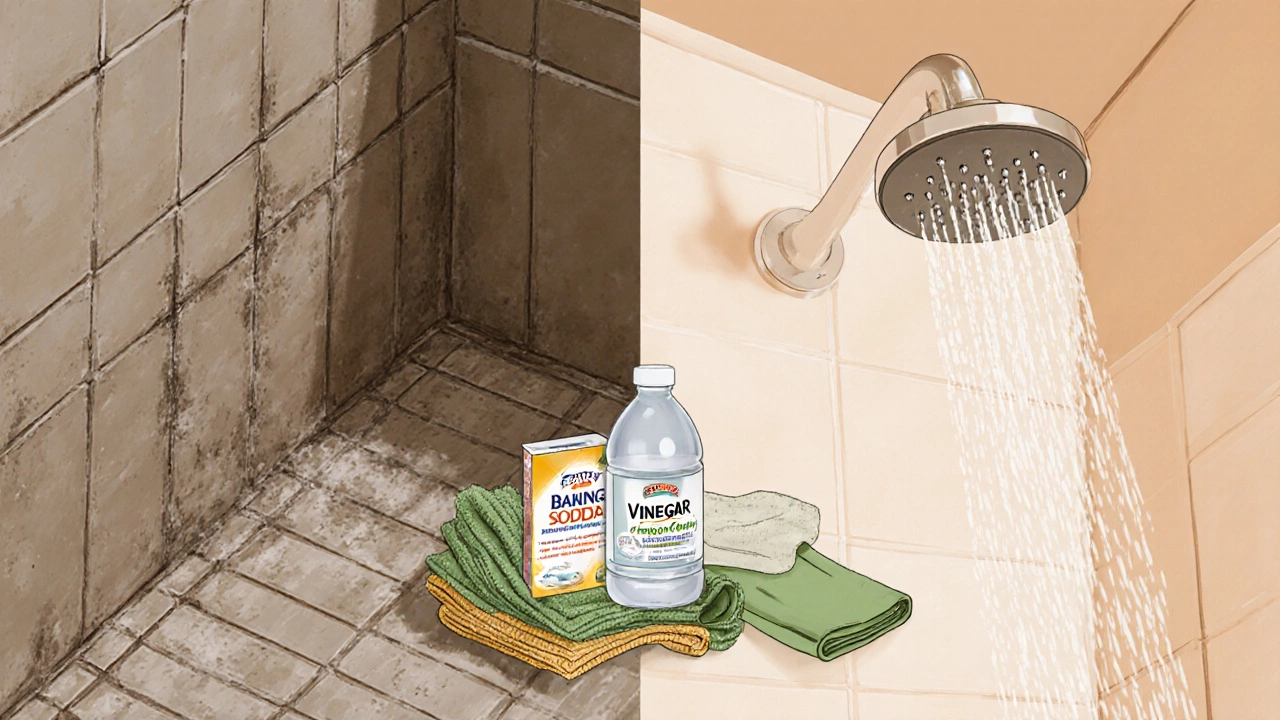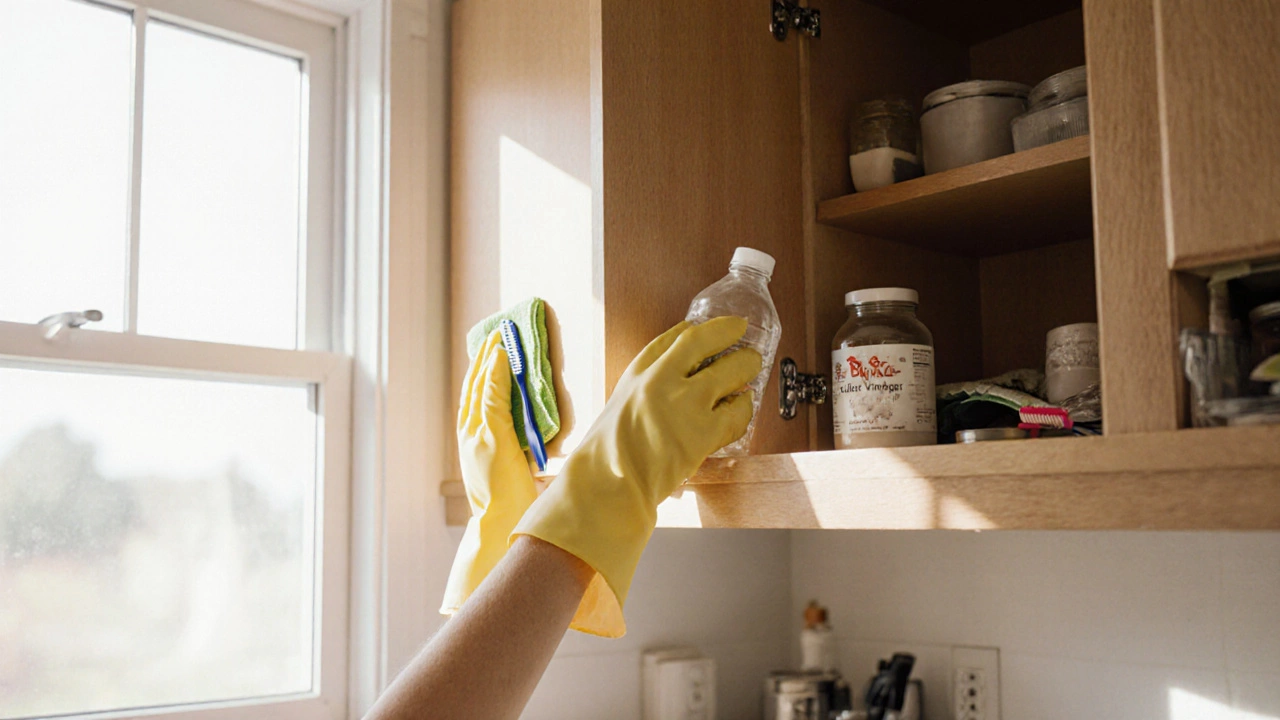Deep Cleaning Time Estimator
Estimate how long deep cleaning your home will take based on size, room count, and factors like pets or allergies. Perfect for planning your cleaning schedule.
Your Deep Cleaning Estimate
Ever looked at your kitchen cabinets and wondered if you’ve ever truly cleaned them? Or noticed the grime around your baseboards that hasn’t budged since last winter? Deep cleaning isn’t just a buzzword-it’s a full reset for your space. And yes, you can do it yourself. No professional team, no expensive equipment, no excuses. But it’s not about scrubbing harder. It’s about knowing where to look, what tools to use, and how to avoid wasting time on things that don’t matter.
What Exactly Is Deep Cleaning?
Deep cleaning means going beyond surface-level tidying. It’s tackling the dirt, dust, grime, and buildup that regular cleaning misses. That includes wiping down light switches, cleaning inside your fridge coils, scrubbing shower grout, vacuuming under furniture, and washing windows from both sides. It’s not weekly. It’s not monthly. It’s usually done every 3 to 6 months, depending on your household.
Think of it like an oil change for your house. You don’t wait until the engine seizes. You do it before the buildup causes damage. Dust mites, mold spores, and bacteria hide in places you don’t see every day. A 2023 study from the Environmental Protection Agency found that indoor air can be up to five times more polluted than outdoor air-mostly from dust, cleaning products, and hidden mold. Deep cleaning cuts that down.
What You’ll Need (No Fancy Gear Required)
You don’t need a $500 steam cleaner to deep clean your home. Most of what you need is already in your cupboard:
- White vinegar
- Baking soda
- Microfiber cloths (at least 10)
- Old toothbrushes
- Rubber gloves
- Extension duster
- Steam mop or regular mop and bucket
- Vacuum with hose attachment
- Glass cleaner
- Disinfectant spray (or make your own with 70% isopropyl alcohol)
That’s it. No magic sprays. No branded kits. These basics work better than most store-bought cleaners because they don’t leave chemical residue. Vinegar cuts grease. Baking soda scrubs without scratching. Microfiber traps dust instead of spreading it.
Where to Start: The Room-by-Room Breakdown
Trying to clean your whole house in one day is a recipe for burnout. Break it down by room. Do one room per weekend, or tackle one section at a time. Here’s what matters in each space.
Kitchen
This is the dirtiest room in most homes. Start with the fridge. Take everything out. Wipe down shelves with warm soapy water. Clean the door seals-mold loves those damp crevices. Then tackle the oven. Sprinkle baking soda inside, spray with water, let sit overnight, then wipe. For the stovetop, use vinegar and a razor blade to scrape off baked-on spills.
Don’t forget the inside of cabinets. Wipe down the tops and sides. Clean the backsplash grout with a toothbrush and baking soda paste. Empty and clean the trash can. Wash the trash can lid. Even the light fixture above the sink needs a wipe-down.
Bathroom
Grout is the enemy. Mix baking soda with water into a thick paste. Apply to grout lines. Let sit for 15 minutes. Scrub with an old toothbrush. Rinse. For shower doors, spray vinegar, let sit 10 minutes, then wipe with a microfiber cloth. No streaks.
Remove the showerhead and soak it in vinegar for an hour to clear mineral buildup. Clean the drain by pouring half a cup of baking soda, then a cup of vinegar. Wait 15 minutes, then flush with hot water. Wipe down the toilet tank, handle, and base. These spots are often ignored but harbor germs.
Bedrooms and Living Areas
Move the furniture. Vacuum under the bed, sofas, and chairs. Dust ceiling fans and light fixtures. Wash throw pillows and blankets-even if they look clean. Wash windows inside and out. Wipe down door handles, light switches, and remote controls. These are germ hotspots.
For carpets, sprinkle baking soda, let sit 20 minutes, then vacuum. It removes odors and lifts surface dirt. If you have area rugs, take them outside and beat them with a broom. Do this once a year.
Laundry Room and Utility Areas
People forget these spots. Clean the washing machine drum with a cup of vinegar and a hot cycle. Wipe the rubber seal. Clean the dryer vent hose-this is a fire hazard if clogged. Dust the top of the dryer. Wipe down the ironing board and clean the iron’s steam plate with vinegar and a cloth.

Time and Effort: How Long Does It Really Take?
A full deep clean of a 1,500-square-foot home takes about 8 to 12 hours spread over two or three days. That’s not a weekend project-it’s a marathon. But you don’t have to do it all at once.
Try this schedule:
- Day 1: Kitchen and laundry room
- Day 2: Bathrooms and bedrooms
- Day 3: Living areas, windows, and baseboards
Work in 90-minute blocks. Take a 15-minute break. Drink water. Stretch. You’ll get more done and feel less drained.
Common Mistakes People Make
Even when people try, they mess up. Here’s what not to do:
- Using the same cloth everywhere. You’re just moving dirt around. Use separate cloths for bathrooms, kitchens, and floors.
- Skipping the ceiling and light fixtures. Dust falls down. If you don’t clean up top, you’re cleaning twice.
- Only cleaning visible areas. Under the fridge, behind the toilet, inside cabinets-these are where the real mess hides.
- Using too much cleaner. Residue attracts more dust. Less is more.
- Waiting until it’s unbearable. The longer you wait, the harder it gets. Don’t wait for a guest to come over.

When to Call a Pro
You can do 90% of deep cleaning yourself. But there are exceptions:
- Carpet stains that won’t lift after multiple attempts
- Mold growing behind walls or under flooring
- Chimney or duct cleaning
- High ceilings or large windows you can’t safely reach
If you’ve got a large home, multiple bathrooms, or health issues like asthma, hiring help once a year for the toughest spots saves time and stress. But don’t outsource the basics. You’re capable. You just need a plan.
Make It Stick: How to Keep It Clean
Deep cleaning is pointless if you go right back to mess. Build habits:
- Wipe down kitchen counters every night
- Do a 10-minute daily tidy-pick up, dust, vacuum high-traffic areas
- Change bed sheets weekly
- Take out the trash before it overflows
- Leave shoes at the door
After your deep clean, put a reminder in your phone for 4 months from now. That’s your next deep clean date. Consistency beats perfection.
Final Thought: It’s Not About Perfection
You don’t need a spotless home to feel better. You need a clean one. Deep cleaning isn’t about impressing people. It’s about breathing easier, sleeping better, and not dreading the next time you open a cabinet. You’ve got the tools. You’ve got the time. Start small. Pick one room. Do it right. Then do the next. Your future self will thank you.
Can I deep clean my home without buying special products?
Yes. Vinegar, baking soda, microfiber cloths, and water are all you need for most tasks. They’re cheaper, safer, and just as effective as commercial cleaners. Skip the branded sprays unless you have a specific issue like tough grease or mold.
How often should I deep clean my home?
Every 3 to 6 months is ideal for most households. If you have pets, kids, or allergies, aim for every 3 months. If your home is low-traffic and you do regular cleaning, every 6 months is fine. Don’t wait for it to look dirty-clean before it gets there.
Is deep cleaning worth the effort?
Absolutely. Studies show that a clean home reduces stress, improves sleep, and lowers exposure to allergens and bacteria. You’ll notice you breathe easier, feel more in control, and even eat better when your kitchen is truly clean. The time you spend now saves you headaches later.
What’s the most overlooked area in deep cleaning?
The inside of cabinets and drawers. People clean the outside but forget the shelves, backs, and corners where dust, grease, and crumbs collect. Wiping these down prevents pests and makes finding things easier.
Can deep cleaning help with allergies?
Yes. Dust mites, pet dander, and mold spores build up in carpets, bedding, and vents. Deep cleaning removes these triggers. Vacuuming with a HEPA filter, washing linens in hot water, and cleaning HVAC vents can significantly reduce allergy symptoms.
